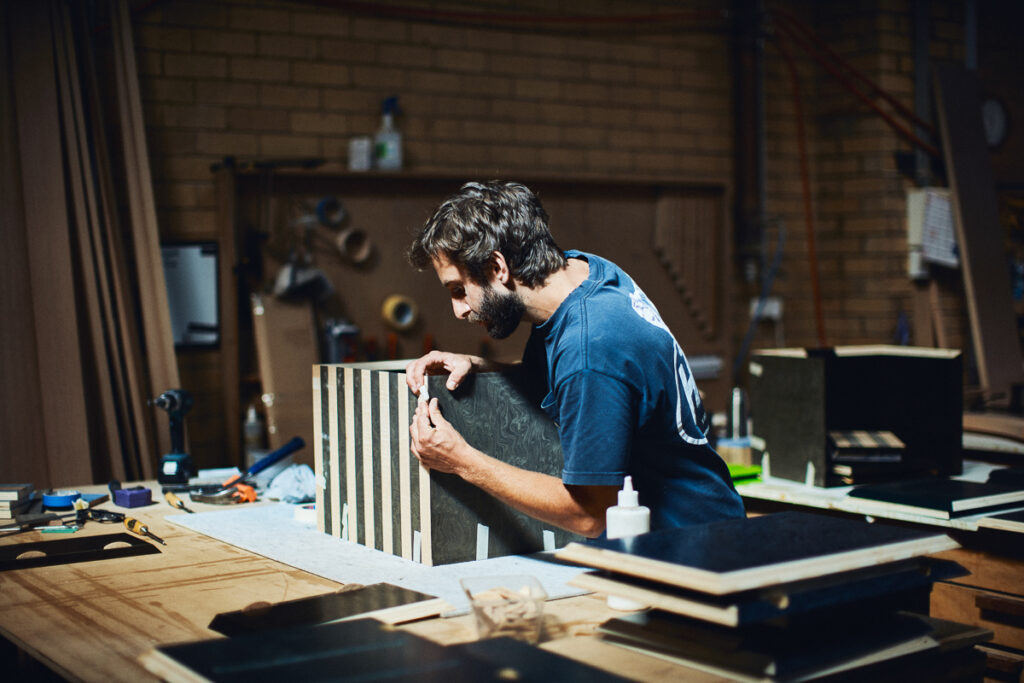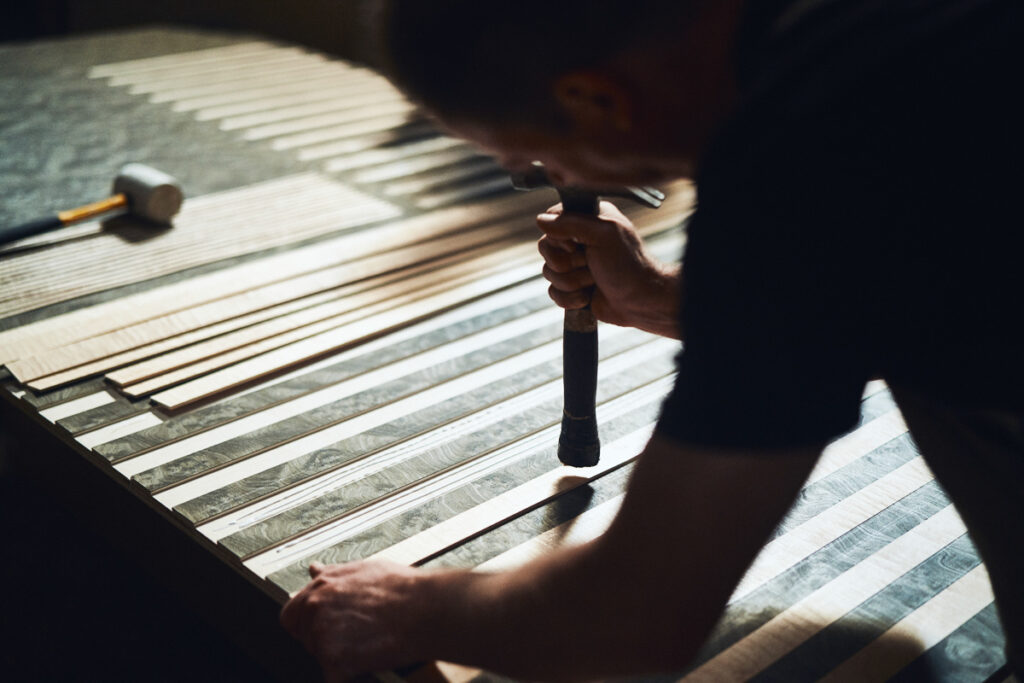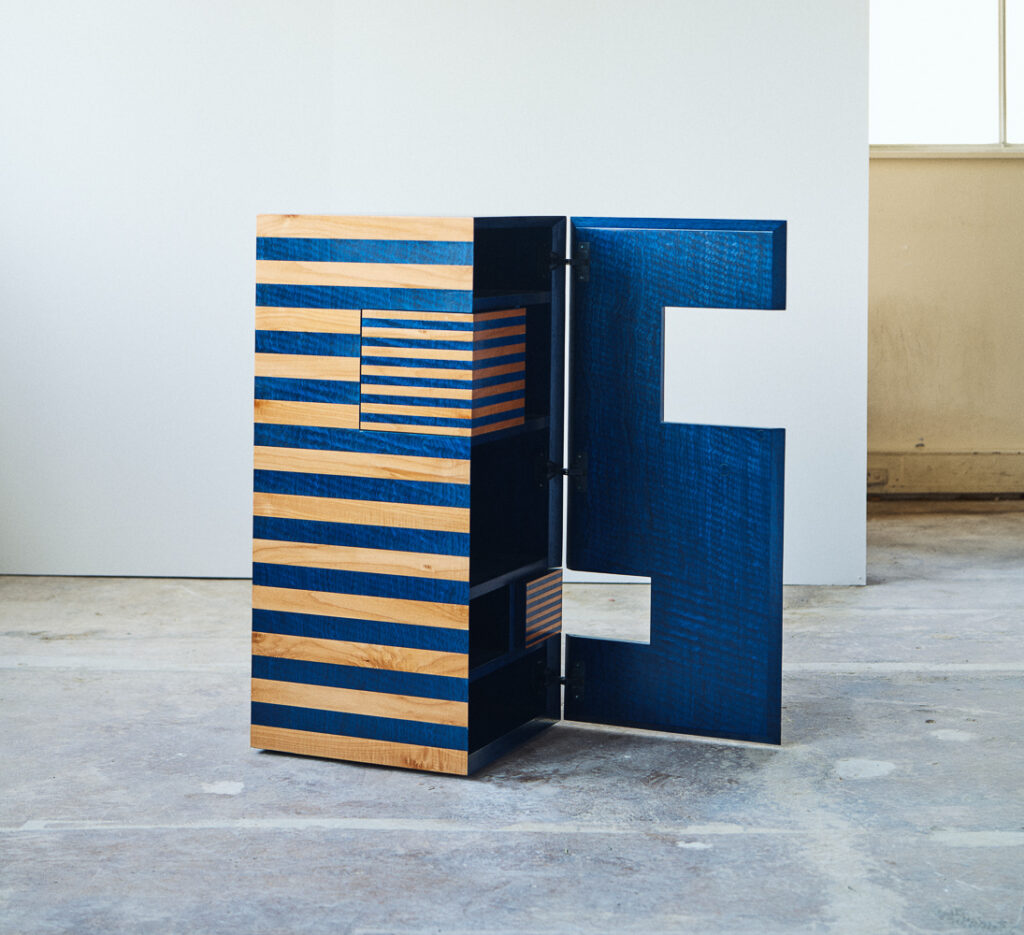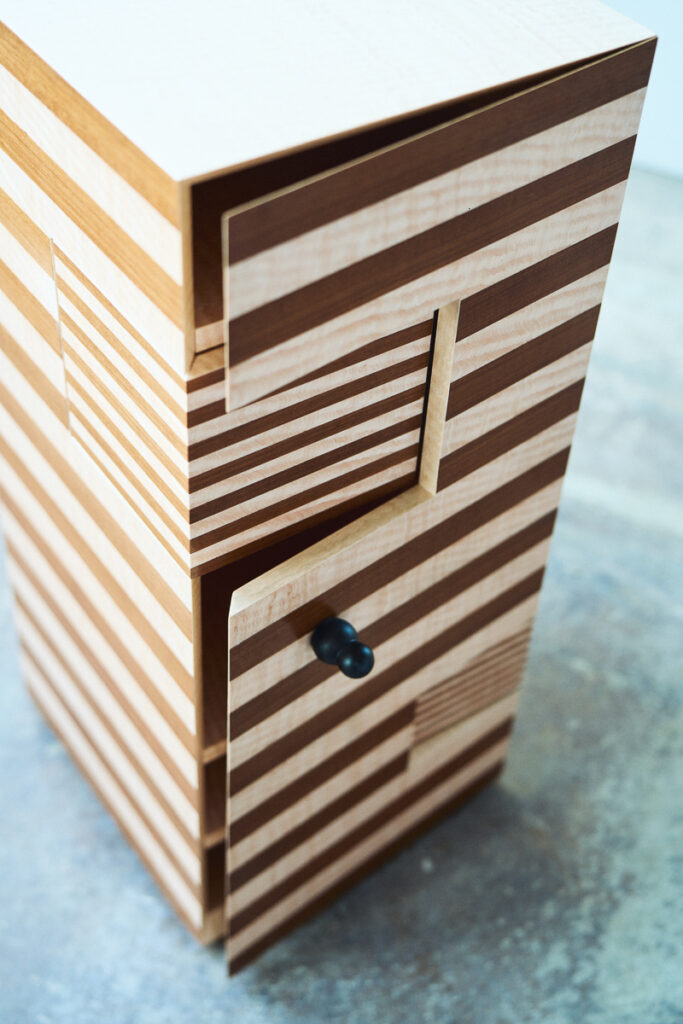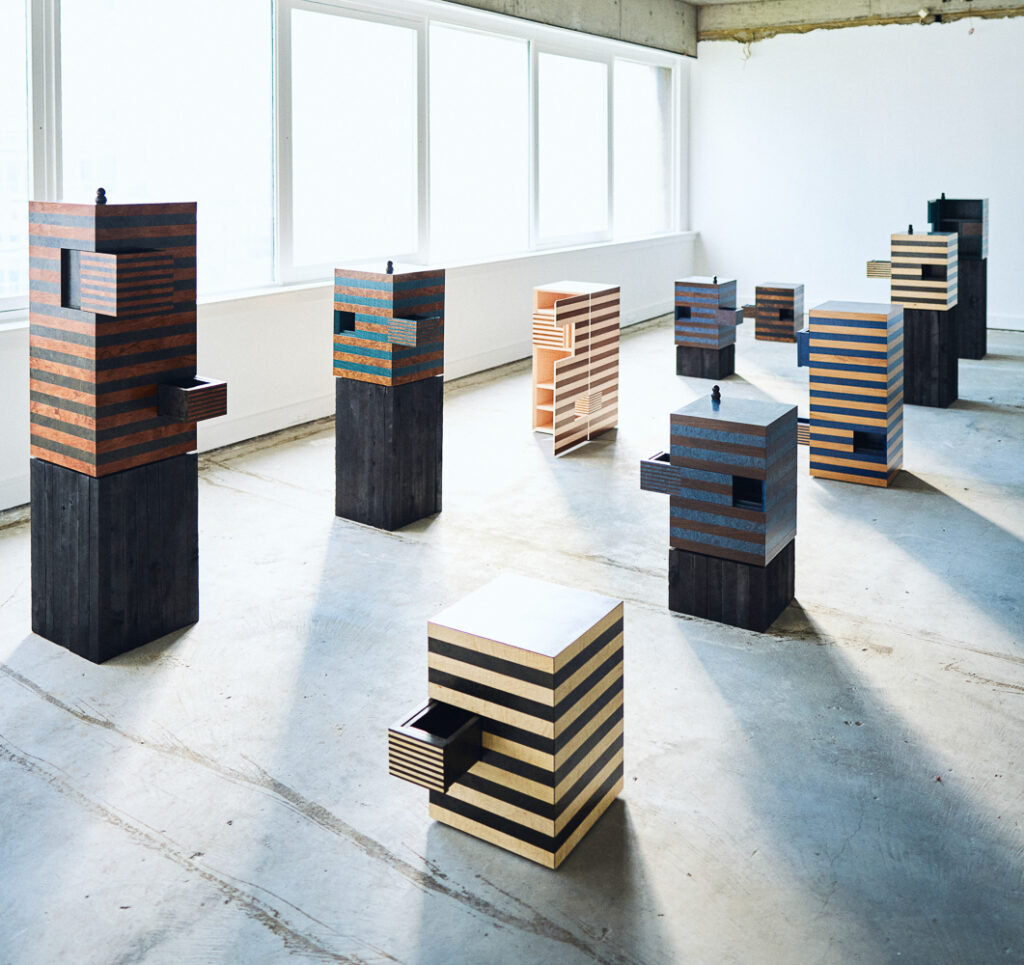
Broached Recall by Broached Commissions, incorporating the historical veneer archive of Elton Group for Melbourne Design Festival, March 2021
For Lou Weis, a new series of commissions based on early modernist veneers helps critically reflect on the trajectory of modernist design.
Just as manufacturing companies recall faulty products, Broached is recalling design periods that have fallen out of favour and correcting them within a current aesthetic.
This collection spans batch manufactured small to medium-sized applied arts objects to bespoke, limited edition, highly complex works.
Broached collections are usually a dispassionate view of a particular moment in history, such as the Australian colonial period or Gold Rush. They are founded on a desire to connect a clearly defined socio-economic moment in history to our contemporary material culture.
Broached Recall differs in that we are starting in the present and tracing a line back to the period that set us on the dire trajectory ecologically minded people are now collectively struggling to veer from. The result is an essay that has all the noise of daily life. Erratic and emotional, it wilfully does not have the answers. It cannot correct in a way we can when we critique the assertions of a design manifesto from the nineteenth century with all of its clear paternalistic, racist biases.
To Recall
- Josh Tyler was lured back to Woodcraft Mobiliar from his hometown in Tasmania to work with Dirk Leuschner from January to March on the production of 11 new works for Broached Recall. Here Josh is pictured dry-assembling a Small Recall Monolith with tape before the real glue-up.
- Dirk Leuschner – founder and operator of fine furniture workshop Woodcraft Mobiliar, with Laura Clauscen Design Director of Broached Commissions and Lou Weis Creative Director of Broached Commissions. Together they are inspecting boards that have been pressed with black veneer and CNC routed to make way for the heritage strips.
- Dirk taps the strips of heritage timber into the routed board with the back of a hammer.
Recalling is both an act of memory and a duty of care undertaken by a manufacturer. Broached is doing both: we are recalling the nineteenth-century underpinnings of modernist design, of modern industry, and bringing these unfashionable pieces back into a factory for correction and fixing.
There is a reason so many period films are based in the middle-to-end of the nineteenth century. It is the moment modern life as we currently know it begins: the vertical electrified city; cinema and photography as the main documentation tools for urban life; a hypermobile urbanism all emerge during this period. Entire new design disciplines are invented, such as the industrial and graphic designer, and the first lifestyle magazines are distributed to a burgeoning middle class. Architecture realigned itself during this period to be more related to modern engineering, enabling it to be further useful to the new client base of emergent market democracies.
For all the claims of originality in modernist design, there is a strong line connecting eccentric works such as Elements of Euclid by Oliver Byrne (1847) to Mondrian, Froebel’s (1782 – 1852) Gifts and Occupations to Kandinsky, Arts & Crafts (1851) to Bauhaus. We see time and again the bedrock of modernity in seminal moments of nineteenth-century art, design and pedagogy.
A real change modernity brings to design is that to be aesthetically contrarian is no longer heretical. Instead, heretics are almost always on a ride of indeterminate speed towards the centre of things. Superstudio renounced mainstream design only to become practitioners of it. Modern entrepreneurs use vibrant aesthetics as a tool for distinguishing themselves in a decentralised marketplace where being different was, and remains, key.
Consequently, a fundamental distinction between Victorian and Modernist design was that modernist designers believed the present to be the most important time, whereas Victorians idealised the Gothic era. Nostalgia was replaced by the vitality, the vibrational hum, of urban immediacy. Yet, this too was foreseen by proto-modernist poets such as Baudelaire and Rimbaud.
The activities of designers sit on the surface of an underlying consistent signal that runs through the Victorian era to the Modernist: the relentless growth of industrialisation and the privileging of technology over nature.
We are recalling what design by necessity of its role must forget: that it gives form to power and what power wants never changes—to glorify itself
Relentless industrial growth came at an enormous cost to the poor and the enslaved. Another major part of our Recall story focuses on the labour forces that enabled supply and manufacture of furniture. Mahogany most likely gets its name from a misapprehension by African slaves that they were looking at a tree from home when working in the West Indies. Red cedar in Australia was logged almost to extinction; its fate tracks the profound rapaciousness of British Colonialism across the island continent. Through force, slave communities laboured in the wilful campaign of pioneers to consume the earth’s resources, with huge swathes of wilderness destroyed around the world. The combustion engine made it possible to do this using two tractors and a huge chain or chainsaws. All we have left of those grand environs are photos, celebrating the most epic of trees brought to ruin showing their felling as an achievement, the starting point for their transformation into useful modern materials.
Broached Recall is also a reflection on the debt of modernity to labour exploitation techniques developed during the colonial period, a history with consequences that continue to reverberate throughout the West today. The British honed a capacity for capturing and dismantling societies over several colonial enterprises, of which Australia was the last great escapade. In the modern era, these techniques morphed into The Shock Doctrine – another Recall for another time.
In no small way, Victorian-era furniture is judged based on this appalling history of human and environmental degradation. Taken in total, the realities of history only make up a small reason for why aesthetic movements fall from favour. Victorian era applied arts staged a few comebacks in the late twentieth-century, but now great swathes can be purchased cheaply in antique stores across the Western world.
People are already nostalgic for the innocence of early modernism, with its claims of bringing simplicity to daily life. Design always strives towards an optimistic reflection of the society it serves, more accurately of the powerful within the society that it serves. Ultimately, it is the product of all the problems as well as the advancements, yet design’s insistence on optimism betrays this mixed role and disavows the weight of historical inheritance so as to make the client feel all the more unique in their moment of history.
The Geometry
- Broached Recall Medium Monolith heritage timber veneer: fruitwood, fruitwood provenance: the fruitwoods were sourced from a small old factory near hamburg, germany before the war in the 1930’s. they were likely originally selected and purchased for the production of biedermeier furniture. Contemporary timber veneer: figured blue
- Broached Recall Medium Monolith Heritage timber veneer: bubinga; Bubinga provenance: Bubinga was a popular veneer in the 90’s. The largest project Elton Group supplied Bubinga to was to the Park Hyatt in Melbourne, a no cost spared fit out designed locally by the Buchan Group in collaboration with the Hyatt’s US designer who spent a full week in the Elton Group Brooklyn warehouse in selection, turning through every piece of veneer. Quilted and figured Bubinga was also specified in the corporate headquarters of Mobil in Australia. Contemporary timber veneer: Figured Maple
The geometries we commissioned from John Warwicker represent the accelerations and continuities discussed above. The pattern languages reflect the works of Oliver Byrne, Hilma af Klint, Albers, Mondrian and Superstudio, to name a few. The graphics were delivered flat and were then extruded into three-dimensional objects.
In material selection, the objects oscillate in the use of heritage and virgin timbers. The interplay between the two—like architecture in a city street where a heavy ornate late nineteenth-century neo-gothic bank abuts a massive mirrored glass skyscraper—creates a tension around the relationship between two highly assertive and deeply influential forms of power. Both eras share a wilful exploitation of habitats for extraction of raw materials, the cutting and hauling of these materials for use in urban environments and the radical expansion of this activity with little regard for consequence. Design works with industry and science to imagine a world that is controlled, ordered, gridded.
What to do with the sediment?
Modernisms and postmodernisms, modernism and postmodernities, have filled every cubic metre of the planet with Co2, plastic in fish stomachs, uranium floating off the coast of Japan, with 1.4 million people in planes at any given moment, with art stuffing massive fairground halls. It not only feels but it is factual to say the air, sea and earth are full and infected with shavings of our industrial productivity.
The “shock of the new” has replaced itself (with itself) so many times that its habits only entertain the newly rich or the shallowly manic. Big money’s games are in the death-throws as well; speculating and exchanging amongst themselves property, art, wine, cars and watches, pretending that all the swapping reflects some kind of engagement with culture.
The endless quoting that postmodernism partially foresaw has manifested into the mainstream with horrific cognitive effects within social media. Here too art and design clamours for favour on the digital platforms and seeks the tech oligarchs as clients who, thus far, as the leaders of the third industrial revolution, have expressed the least capacity for an aesthetic direction to mask, and thereby humanise, their exploitative practices.
In our age, the phone has become a wand; tapping it promises magical returns, but only delivers anti-climaxes. The life the phone enables is one of constant distraction and endless bookings; a life of constant, disembodied anxious fingering masquerading as spontaneity. Because most people maintain a relatively normal grounded community, the intense hyper-mobility is actually lived by a few people who diarise this life constantly and are followed by millions for their commitment to this psychotically disorienting life of constant flux.
These largely meaningless social archives find their purpose when harvested by tech companies and government agencies. This is our current juncture; we stand on an outmoded industrial floor that is killing us and beneath a digital cloud we pretend is weightless but is as connected to the earth as real clouds are to the seas and the mountains.
The digital layer is moving fast, throwing shadows everywhere, distracting us from the urgent need to transform the industrial outmoded systems. Meanwhile, design is being eaten away by the emergence of AI systems that automate many of the tasks designers do routinely. Yet even in the face of redundancy, design cheers on change because it believes in the machine, in speed, in mobility, in taking the brief and delighting the master.
By grabbing antiques and gridding them we are, to steal a metaphor from Back to the Future, “connecting the taco shells of time”; showing how little has changed in the role of design within the economy over a one-hundred-and-twenty-year period. As Philippe Starck said the “purpose [of designers] is to serve others.” But few designers pause to sum up who that “other” is and our current set of crises (of democracy in the era of social media, of climate change and mass extinction) shows that design is a micro not macro participant in economies. It does not correct; it agnostically enables energy flows.
Broached Recall is not attempting a new direction in design. Nor are we pointing to a cure to what has been articulated in this essay. This is not about upcycling. Broached Recall is a statement on how socio-economic upheaval coincides with a catastrophic severing with the material culture of the society that is being replaced.
In western society, the habit of replacing everything from objects in a home to pristine wildernesses is not shocking but a desired state of being. An extension of our entitlement to control our environment.
The most desirable changes and innovations are ones that can be scaled; excite attention around the importance of the idea, and then exert control through risk minimisation strategies. Industry pays design to innovate, but the only innovations that are “successful” are scalable. Growth is still the mantra of market economics.
What does an object representing an obsession with scalability and risk minimisation look like? What does an object devoid of social or ecological conscience look like? Does it look like the grid? These are the questions Broached Recall wrestles with.
Our society is accelerating towards one dangerous point. Some of the consequences are familiar, such as increasing wealth disparity driving right-wing populism. But there is an unfamiliar accelerant: climate change. It genuinely reflects our strange current paradigm that is defined by hyper-mobility and stagnant productivity. We are apathetically generating a planet that no longer sustains human life, or for centuries prior to that finality, a global population living through Silent Spring; a world wracked by tumultuous weather, toxic air and mass extinction.
Market democracy’s obsession with growth is akin to religious fanaticism; impervious to rationality and evidence-based science, thus consequently incapable of deviating from dogma causing the enormous helplessness and apathy felt by many, across the political spectrum, who are passionate or even just pragmatic about dealing with the current problems.
This inertia has created a strangely muting of utopian visions of the future, as Point 1.3 of the Accelerate Manifesto by Alex Williams and Nick Srnicek makes clear;
“In contrast to these ever-accelerating catastrophes, today’s politics is beset by an inability to generate the new ideas and modes of organisation necessary to transform our societies to confront and resolve the coming annihilations. While crisis gathers force and speed, politics withers and retreats. In this paralysis of the political imaginary, the future has been cancelled.”
What does this cancellation mean for design? What does it look like in an object making a statement about design’s relationship to modes of production in modernity? When we know the society we give order to—and are ordered by—is unsustainable, how do we act ethically?
This is another design layer of the Broached Recall collection: to formally articulate a dead end. One we are hurtling towards at ever great speed, one we cannot walk back from, that the scientists say is already “baked in” to the coming decades. By recalling the antiques of the Victorian period, we revisit the origins of this vast disregard for the planet. This first international style was aesthetically obsessed with nature whilst plundering it on every inhabited continent. Nature was to be feared, bemoaned and ultimately categorised and controlled. Today many still believe that technology will “fix” climate change so we can continue business as usual whilst hundreds of species go extinct each week.
We are recalling what design by necessity of its role must forget: that it gives form to power and what power wants never changes—to glorify itself, to always be in control and persuade others to vote, pray, consume and sometimes even think in a manner that suits its interests. Because the desires of power remain more or less the same, it is design that must reinvent the language that enthuses people to engage.
This first Recall reconnects modernism in design to its nineteenth-century forbearer. The continuities run deep; the modern inherited industrial systems, pedagogies and nascent aesthetic languages from its elders. It was the client that changed and so did the speed and scale of production. The industrial design products of Christopher Dresser (1834-1904) represent a transition between these two worlds. His toast rack is still manufactured by Alessi a century after they were designed. Dresser is another example of how modern design was a slow migration rather than a break with previous styles. Dresser’s work displays an incremental stylistic shift towards reductionism, what became the central principle of modernism. Hilariously, designers claimed it was their idea, rather than the client’s, to simplify design to elemental forms. Doing so ignores the fact that the entrepreneur is equal to the commercial artist as being the most creative members of our society.
The world is full of products and denuded of life. Broached Recall is our attempt to show the design world’s wilful contribution to this current predicament.
About Elton Group veneers
Elton Group started as W Elton and Sons in 1943. At age 17, in the late ’60s Michael joined his uncle Werner Schindler, Sydney based but globally recognised in the timber business. As part of his initiation and education, Michael travelled with Werner to Europe on buying trips to Italy and Germany,
During these trips in the early 1970s, Michael was introduced to Wolfgang Vetters renowned veneer merchant with knowledge, contacts and relationships to source from mills all over the world. Wolfgang was considered top of his game in expertise and veneer sourcing and procured Oaks in Europe, Cherries from the US, and Bubinga from Africa. Through this relationship, Michael was personally introduced to mills and veneer producers all over the world and travelled to several remote locations to view and select in the years to follow.
The timber veneer industry is an ancient one, and with today’s technology and access to information, it is almost impossible for us to appreciate that business was conducted without forklifts and before the internet, digital scanning, and recording. Because of this, the eye was trained, memories were impeccable, knowledge implicit and relationships vital and multi-generational. Many transactions and inventories were recorded by hand in notebooks, others on typed, carbon copied pages filed in original manila folders.
Once veneer selection was made, crates of veneer were shipped to Elton Group in Australia., where each log and flitch would be re-measured, re-graded and itemised by Michael for the Australian market.
For this exhibition, Broached turned through Elton Group’s expansive historical archive to select seven heritage timber veneer species which have been paired with Elton Group’s colourful contemporary reconstructed veneer range. By carefully matching new and historical veneers each Recall object is a unique dialogue between the past and present global management of the timber industry.
The veneers selected for the Broached Recall collaboration are, in effect, a time capsule representing a different era of timber veneer sourcing, selection and specification.
The collection of veneers range in age from circa pre-war 20th C to the ’70s, ’80s and early 1990s. The veneer bundles and flitches were inspected, turned by hand and selected by eye, often labelled by a simple chalk marking only and agreed on a gentleman’s handshake. To select the veneers meant a trip to personally inspect and pick.
The provenance of some of the heritage veneers is known, and others cannot be confirmed but it is likely most originated from German and US mills, known for having the best stock, and expertise in sourcing veneers from all over the world.
Eveneer is a range of sliced, real wood veneers made from rotary peeled timber that is colour enhanced, reformed to a square log and then re-sliced into rectangular veneer sheets, made by the world’s leading manufacturer of reconstructed veneer, Alpi, in Italy from Poplar grown in agricultural plantations and timbers grown in sustained yield forests.
As a natural timber product, no two Eveneer sheets are the same. Eveneer comprises an initial peeling followed by slicing, that is why it is known as reconstructed, reconstituted, recon or recut.
Who designed and made it
Broached team:
Creative Director: Lou Weis
Design Director: Laura Clauscen
Design: Joseph Gauci-Seddon
Project team:
Recall Pattern Languages: John Warwicker
Material Partner: Elton Group
Fabrication: Woodcraft Mobiliar, Emily Denton, Axolotl
Film and Photography: Paul Barbera
Film Animation: Sam Hains
Special thanks to Adrian Verdejo for the use of his performance of James Tenney’s Septet for Six Electric Guitars and Bass
About Lou Weis
 Lou Weis is the creative director of Broached Commissions an object design studio that has the history of globalization – the objects and blended cultures it has created – as its focus. Broached has created four collections since founding in late 2011 and is set to launch its fifth collection MONSTERS by Trent Jansen in mid-2016. Lou is also a creative strategist for corporate clients including Misschu, UTS design faculty, Platform Strategy Asia and Molonglo Group to name a few clients from 2015.
Lou Weis is the creative director of Broached Commissions an object design studio that has the history of globalization – the objects and blended cultures it has created – as its focus. Broached has created four collections since founding in late 2011 and is set to launch its fifth collection MONSTERS by Trent Jansen in mid-2016. Lou is also a creative strategist for corporate clients including Misschu, UTS design faculty, Platform Strategy Asia and Molonglo Group to name a few clients from 2015.

